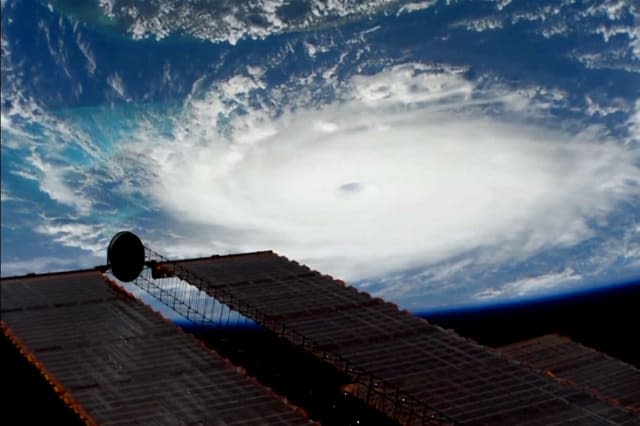Hurricane Dorian: Bahamas slammed by category five storm
Hurricane Dorian has struck the northern Bahamas as the catastrophic Category 5 storm brought 185mph winds that ripped off roofs and tore down power lines.
Hundreds hunkered in schools, churches and other shelters for protection.
The second-strongest Atlantic hurricane since 1950, Dorian hit land in Elbow Cay in the Abaco Islands after authorities made last-minute pleas for those in low-lying areas to evacuate.
But officials recognised there were not many structures on higher ground on the largely flat archipelago south-east of Florida.
Millions from Florida to the Carolinas kept a wary eye on the slow-moving Dorian amid indications it would veer sharply north-east after passing the Bahamas and track up the US south-east seaboard.
Authorities warned even if its core did not make US landfall and stayed offshore, the potent storm would likely hammer coastal areas with powerful winds and heavy surf.
The National Hurricane Centre in Miami said Dorian's maximum sustained winds at landfall were 185mph, up from 175mph. It is moving west at 7mph.
"Catastrophic conditions" are occurring in The Abaco Islands and expected across Grand Bahama later in the day, the centre said.
Dorian was second only to Hurricane Allen in 1980, with its 190mph winds.
"It's going to be really, really bad for the Bahamas," Colorado State University hurricane researcher Phil Klotzbach said.
In the northern stretches of the Bahamas archipelago, hotels closed, residents boarded up homes and officials hired boats to move people from low-lying areas to bigger islands as Dorian approached.
Bahamas Prime Minister Hubert Minnis warned any "who do not evacuate are placing themselves in extreme danger and can expect a catastrophic consequence".
Kwasi Thompson, minister of state for Grand Bahama island, urged residents to "please, please heed the warning".
He added: "We have no more time available."
Still, dozens of people were ignoring evacuation orders, officials said, and they were warned that they were placing their lives in danger.
"The end could be fatal," said Samuel Butler, assistant police commissioner.
"We ask you, we beg you, we plead with you to get to a place of safety."
The Government has opened 14 shelters across the Bahamas.
"We cannot stress the amount of devastation and catastrophic impact that Hurricane Dorian is expected to bring," said Shavonne Moxey-Bonamy, the Bahamas chief meteorologist.
Over two or three days, the slow-moving hurricane could dump as much as 4ft of rain, unleash devastating winds and whip up a dangerous storm surge, private meteorologist Ryan Maue said.
Government spokesman Kevin Harris said Dorian was expected to affect 73,000 residents and 21,000 homes.
Authorities closed airports for The Abaco Islands, Grand Bahama and Bimini but Lynden Pindling International Airport in the capital of Nassau remained open.

The slow-crawling storm was predicted to take until Monday afternoon to pass over the Bahamas and then turn sharply and skirt up the US coast, staying just off Florida and Georgia on Tuesday and Wednesday and then buffeting South Carolina and North Carolina on Thursday.
The National Hurricane Centre issued a hurricane watch on Sunday morning for Florida's east coast from Deerfield Beach north to the Volusia and Brevard county line.
The same area was also put under a storm surge watch. Lake Okeechobee was put under a tropical storm watch.
Florida governor Ron DeSantis warned residents along the state's densely populated Atlantic coast: "We're not out of the woods yet."
He noted some forecast models still bring Dorian close to or even onto the Florida peninsula.
"That could produce life-threatening storm surge and hurricane-force winds," Mr DeSantis said.
"That cone of uncertainty still includes a lot of areas on the east coast of Florida and even into central and north Florida, so we are staying prepared and remaining vigilant."
Palm Beach County announced a mandatory evacuation for the eastern half of the county beginning at 1pm on Sunday after the morning forecast put the area in a tropical storm warning.
The evacuation includes mobile homes, substandard housing, low-lying areas prone to flooding and homes along the Intracoastal Waterway and on barrier islands.
South Carolina governor Henry McMaster declared a state of emergency, mobilising state resources to prepare for potential storm effects.
President Donald Trump already declared a state of emergency and was briefed about what he called "a very, very powerful hurricane".
"We don't know where it's going to hit but we have an idea, probably a little bit different than the original course," Mr Trump said.
"But it can change its course again and it can go back more toward Florida."


